In cretan culture, the bull is everywhere. Horns of consecration adorned the top of Minoan shrines and may have decorated palaces at Knossos, Mallia, and Phaistos. Great ceremonial axes of bronze, perhaps suggesting the sacrificial slaughter of bulls, were recovered from palatial contexts. Objects such as the Hagia Triada sarcophagus, dated to the early 14th century BC, show cattle trussed in preparation for sacrifice.
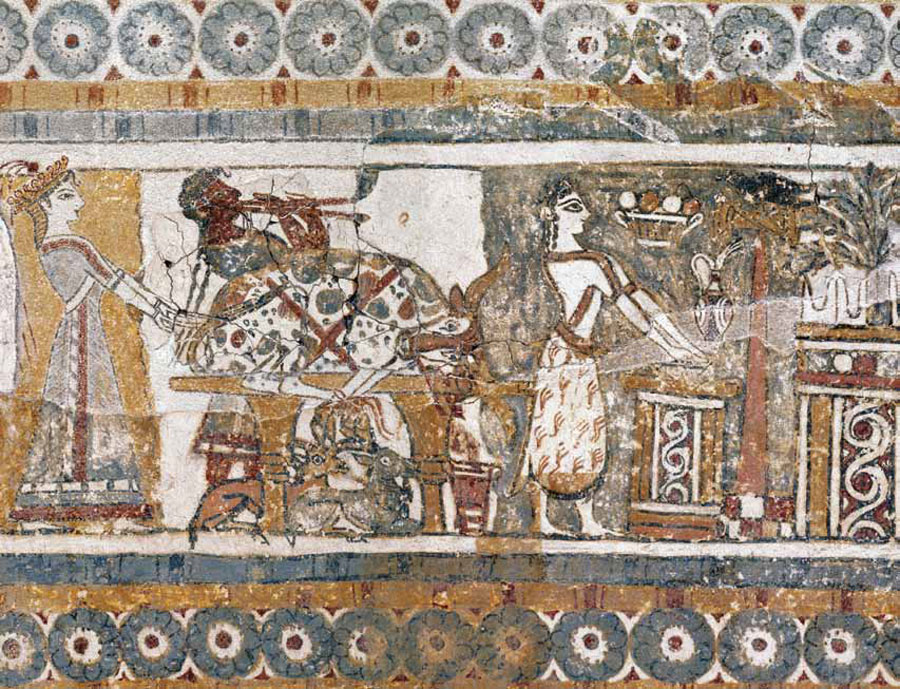
In every medium imaginable, from gold rings to terracotta figurines, from stone seals to frescoes in relief, the image of the bull permeates the Minoan world. Furthermore, depictions of bulls and bull-leaping figure prominently in the pictorial decoration of Neopalatial Knossos. Major entrances leading to the center of the palace complex were adorned with wall paintings of bulls and bull-leaping. Bulls also figure on rhyta (plural of rhyton), or more properly, as rhyta. The Cretan rhyta—pouring vessels with two openings—were probably derived from Syrian antecedents, but the Cretan vessels evolved into objects of exceptional size and beauty. Vessels like the Bull’s Head rhyton from Knossos—carved out of serpentinite (sometimes referred to as steatite) and decorated with shell, rock crystal, jasper, and gold—were too heavy to be used in anything but ritual settings. The Boxer rhyton from Hagia Triada, carved in relief with scenes of boxing and bull-leaping, weighs 1 kg (2.2 pounds) empty and 3 kg when full. These rhyta are perforated at the bottom and could only hold liquid as long as they were plugged, so they must have been ceremonial containers. One possibility is that they dispensed wine and were used in a banquet setting. Nanno Marinatos, however, has persuasively argued that they were used to hold blood from sacrificial animals, which was collected and then poured onto the ground as a libation. The Hagia Triada sarcophagus shows women pouring what may be blood from the sacrificial bull into a large krater.
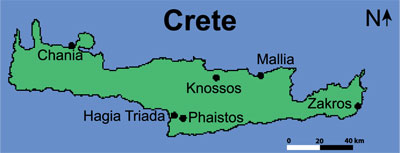
A religious function is also suggested by the portrait-like quality of some rhyta. In contrast to the stylized depictions of priestesses, princes, and even deities, the Bull’s Head rhyta are remarkable for their vividness and their individuality. The lyre shape of the horns and the ring of white around the nostrils have suggested to some that the animals may be examples of the Greek steppe breed still to be found today in northern Greece. The portraits would have been the centerpiece of any gathering at which they were used. If such a gathering were the feast following a sacrifice at which the bull was consumed or its meat distributed, a formal libation from a vessel imitating the bull’s head would have constituted a ritual re-enactment of the bloodletting that began the sacrifice. The savagery of the animal’s slaughter was replaced with the formal dignity of libation. The disposal of the rhyton after the ceremony amounted to a second killing.
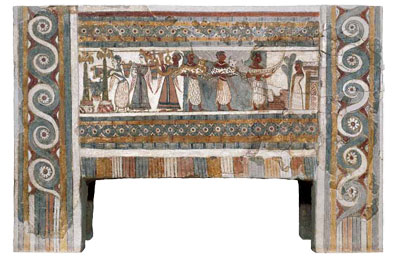

A deep-rooted tension between the wildness of the bull and the need to master it also appears to underlie the most famous Minoan institution involving bulls: bull-leaping. The details of this practice are much contested. At one extreme are those who deny such performances ever took place, while at the other are those who offer a detailed breakdown of how the ritual was performed. The latter base their conclusions on the various depictions of bull-leaping shown on ceramics, seals, rings, ivory figurines, and frescoes. Based on these artistic representations, Sir Arthur Evans, excavator at Knossos, believed that the process consisted of four clearly defined phases as the leaper approached, grasped the bull by the horns, vaulted over onto the animal’s back, and then sprang onto the ground. Subsequent studies by A. Sakellariou and John Younger assembled evidence for variations on Evans’ schema until a range of styles was identified and associated with specific periods in Late Minoan culture. These changes in style make little sense divorced from an actual practice; they are therefore taken as evidence that a “sport” of bull-leaping did occur. The conclusion of Younger’s 1976 study sums up the connection between artistic representations and the performances they recall: “In conclusion, bull-leaping begins to appear in artistic representations toward the beginning of the Late Bronze Age in Crete and on the Mainland. The main system of performance probably followed that of the Diving Leaper Schema. When bull-leaping itself was discontinued, perhaps towards the close of the LB IIIA or the beginning of the LB IIIB period, 1340 BC, later representations depicted the leaper in the floating pose (Type III), a pose not copied directly from the sport.” The ceremonial courts characteristic of Minoan palaces are often taken to be the locations for the sport, serving as Minoan bull-rings.
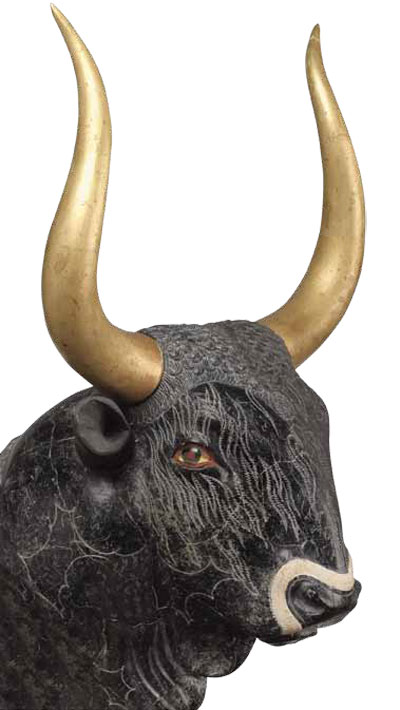
Despite the assurance of Evans’ reconstruction, or perhaps in reaction to it, there are those who seriously doubt whether it is at all possible to leap a charging bull, particularly when, as in most of the scenes depicted in Minoan art, the bull has its head up, with its horns vertical. J. Alexander MacGillivray, for example, asserts that no person ever jumped over a bull’s back on Crete or anywhere else. He suggests instead that the artistic depictions of bull- leaping are representations of a celestial drama. “Orion confronts Taurus, composed of the Hyades and Pleiades (the seven sisters), while Perseus somersaults with both arms extended over the bull’s back to rescue Andromeda.” Thornhill’s illustrations for John Flamsteed’s 1729 Atlas Coelestis show how easily constellations can be seen as snapshots of mythical episodes.
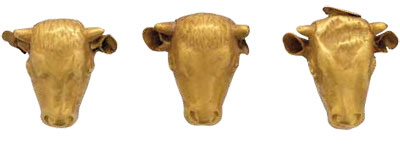
Yet a cosmological reading need not preclude a ritual performance, and certainly does not disprove its existence altogether. Moreover, the lack of any Minoan liturgical text comparable, for example, to the Epic of Gilgamesh makes it hazardous to speculate about Minoan cosmology in anything but the broadest terms. We can read the Assyrian seals with some degree of confidence because we have a textual narrative that explains the scenes depicted, but we do not have anything comparable for Crete, unless we rely on later stories regarding Minos, Pasiphae, and the Minotaur—stories which were not written until after Crete had come under Greek control. If there were Bronze Age myths accompanying the stories of Pasiphae and Minos, they certainly were contaminated in the process of transmission. Here we come up against an abiding difficulty in recreating the particulars of Bronze Age religion: interpretation without textual support must remain tentative. Since we do not have the Cretans’ stories about the stars, we cannot assume that they identified Orion, Taurus, Andromeda, and the rest in the same way as the later Greeks or their own contemporaries in the Near East. Even if we were to suppose, reasonably, that the astrological traditions of the Near East were familiar to the Cretans, their existence alone would not be enough to dismiss bull-leaping as modern invention, or to read the scenes of bull-leaping as purely symbolic.
The variety and specificity of the scenes, in fact, point towards actual performances. Why else would assistants be shown holding the horns? Why in some cases would two animals be shown? In most depictions the bull is charging but in at least one instance the great beast is calmly seated on the ground with its legs folded neatly beneath it. In another notable case the bull has begun to mount what looks like an altar, his forelegs raised above the ground and awkwardly hooked onto the stone blocks. These variations make no sense if all the artistic renderings refer to the same single cosmic drama. If on the other hand they commemorate specific performances, the differences between various depictions are intelligible. As with the realistic rendering of individual animals on bull’s head rhyta, the scenes of bull-leaping suggest an interest in commemorating actual events rather than representing a cosmological story.
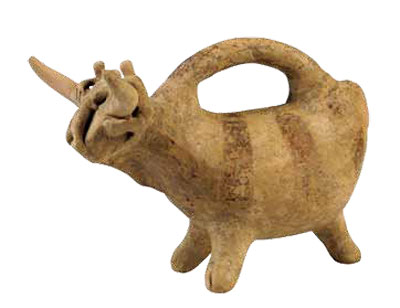
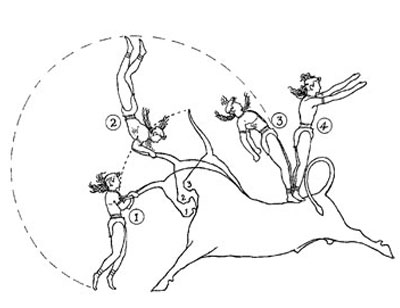
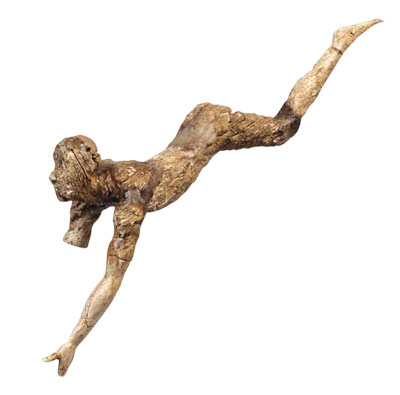
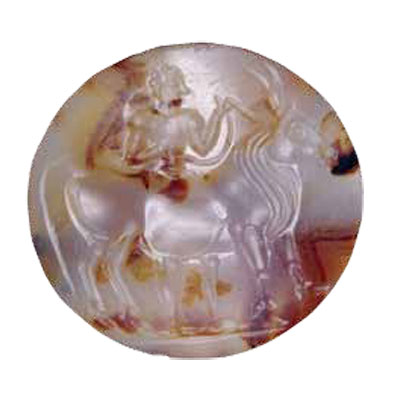
The only compelling objection to the existence of real bullleaping, in fact, is the assertion that it is physically impossible, a claim often made in discussions of contemporary bull sports. Yet in the southwest of France, a version of bull-jumping is still practiced regularly in a form that is an almost exact parallel of the Minoan version: the course landaise. The animals employed are not attacked, stabbed, or slaughtered by the participants. Instead, the emphasis is on athleticism. In one event, for example, the leaper vaults over the body of the charging cow. In a variation of this, the saut de l’ange translated as “the angel’s leap”), the jumper leaps straight along the same axis as the charging animal. It looks exactly like the flying leap depicted in Minoan glyptics. Other leaps include a somersault over the cow’s back, the saut á pieds joints (“jump with feet tied together”), in which the leaper thrusts his legs forward while leaping vertically, and the most difficult of all, the saut vrillé (“twisting jump”), in which the sauteur performs a pike while leaping. I watched the youth championships held in the small French town of Le Houga in November of 2010 and can personally attest to the grace and skill of the young athletes, as well as the speed and aggression of the animals. One popular animal or vache landaise, called Manolita, managed to knock two boys over and scared another one clear out of the ring!
Comparisons with the course landaise raise some intriguing possibilities for our understanding of Minoan ritual. For example, depictions of Minoan bull-leaping involving the killing of animals are rare, and it is possible that the point of the exercise was not to kill the animal but to demonstrate superior skill. The organization of the course landaise also raises questions regarding bull-leaping as an institution. Senta German has recently proposed that Minoan bull-leaping should be seen as a performance carried out by young men of high status. This is a plausible interpretation, but there is another possibility. In the modern version of the sport, the performance is only one part of a larger system of both cattle production and specialized training, consisting of sixteen ganaderias, which function as breeding farms for the 1,200 vaches landaises, the breed specifically raised for the sport, and as ecoles taurines, training schools for the toreros. The same may have applied in Crete, so that rather than high-status youths engaging in acts that functioned to advertise and reinforce social hierarchy across Minoan society, these Cretan bull-jumpers were specialists from the place that was the home of bull-leaping: Knossos. In 1995, commenting on the distribution of bull imagery in Minoan art, Paul Rehak noted, “So prominent is this bull imagery that one suspects that its dissemination reflects an institutionalized source, perhaps the elite who controlled the Knossos palace.” Depictions of bull-leaping, though popular at Knossos, are uncommon at the other Minoan palaces, although actual performances surely took place in the great courts of these palaces. Bull-leaping elevated the palaces as ceremonial centers, since only palaces were designed for spectacle, but the institution required more than priests and hieratic processions. It depended on skilled athletes and suitable animals. By monopolizing the stock and the specialized personnel on which the institution was based, Knossos asserted its cultural dominance of Crete.

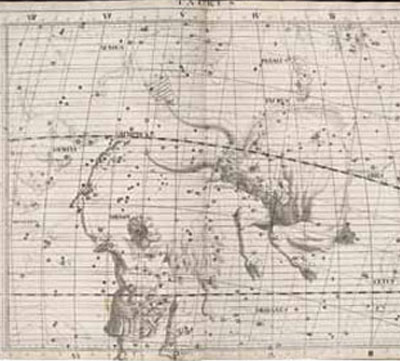
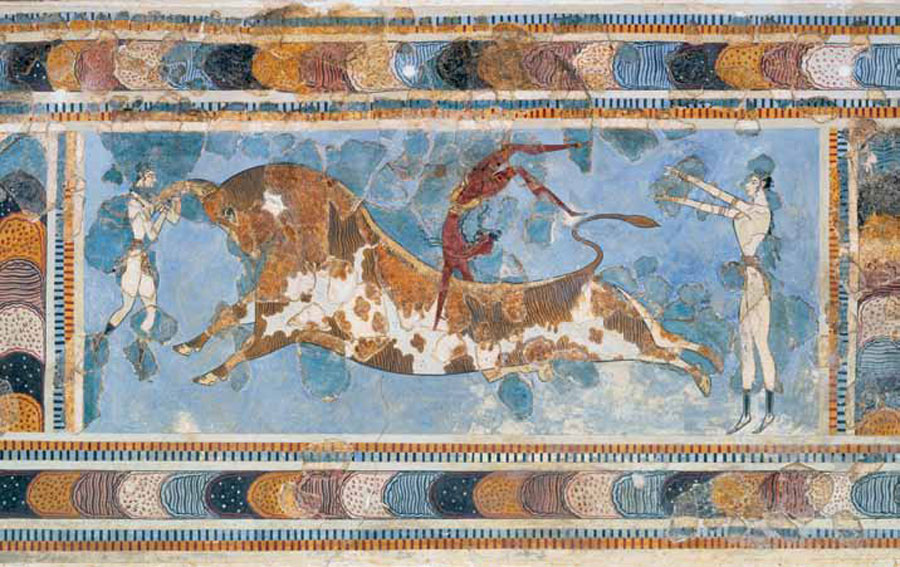
Bull-leaping was thus a centerpiece of Minoan life. It may have been viewed as a sacred re-enactment of a cosmic drama with roots going back to earlier Near Eastern religious systems. Such connections with Egyptian and Near Eastern cosmology helped make the Cretan bull cult exportable: excavations within the last 20 years in Egypt at the Hyksos capital of Avaris (Tell el-Dabca) have brought to light wall paintings dating to the 16th century BC showing scenes of bull-leaping, suggesting that the practice was already known outside of Crete well before the end of the Bronze Age. Similarly, Canaanite seals reflect an awareness of the practice, as do seals found at Alalakh in Syria dating to the 17th century BC. The exact details of the cult, especially the narrative that complemented the ritual, are probably irrecoverable, but the existence of such a dangerous performance shows that Cretan religion reflected the same legacy of pastoralism witnessed throughout the stratified states of the Bronze Age eastern Mediterranean: the compulsion to demonstrate in myth and ritual man’s control of nature through mastery of the bull.
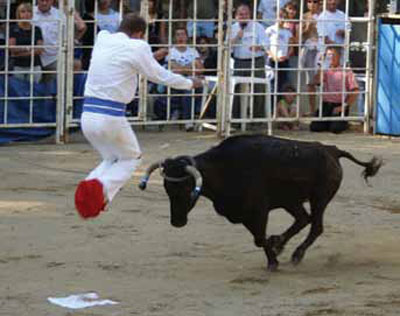
As in Egyptian and Near Eastern bull cults, Minoan bullleaping gave expression to a tension that underlies man’s somewhat tenuous mastery of nature, reaffirmed each time human triumphs over animal. Not coincidentally such cults flourish in societies as they become increasingly stratified, as the affirmation of human prowess serves by analogy as an affirmation of social order. For this reason bull-leaping was a public performance, displaying the theatrical quality that is a distinctive feature of Late Minoan society. Recent studies of Knossos have emphasized this aspect of Minoan culture. Neopalatial Knossos may have been as much a ceremonial as an administrative center, which would help to explain the prominence of theatral areas here and at the other palaces. The carefully designed entryways leading to the central court were decorated with reliefs that repeated certain topoi or traditional themes such as processions and bull-leaping, suggesting the very rituals which one would witness upon entering. If the frescoes throughout the complex can be read as guides to the performances that occurred there then there is every reason to believe that the palaces were the focal points for an increasingly hieratic society, in which religious celebrations such as harvest festivals were the major social events. There is also evidence for the use of complex proportional schemes, such as the Fibonacci sequence in the articulation of units of ashlar masonry in the west façades at Knossos, Mallia, and Phaistos during the Second Palatial period, suggesting that the design of the public space, like the decoration of the palaces, was meant to evoke the importance of the activities that occurred here. Like any rituals, these performances were ephemeral, but carved gold rings depicting bull-leaping commemorated the events. These rings were popular among Minoan officials, members of the Minoan elite, who favored scenes of bullleaping. We can infer the high status of the individuals who used these rings from the fact that very similar sealings from the rings have come to light at various sites in Crete, from Chania to Zakros, and even from the Cycladic island of Thera. Fifty-three sealings from ten so-called Knossos replica rings have been found so far, and of these ten, six depict bull-leaping. The ideological significance of the ritual was paramount.
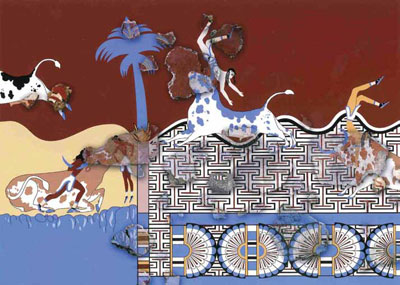

Jeremy McInerney is Davidson Kennedy Professor of Classical Studies and Chair of the Department of Classical Studies at the University of Pennsylvania.
FOR FURTHER READING
Evans, A. The Palace of Minos: A Comparative Account of the Successive Stages of Early Cretan Civilization as Illustrated by the Discoveries at Knossos. London: Macmillan and Co., 1921.
German, S.C. Performance, Power and the Art of the Aegean Bronze Age. Oxford: Archaeopress, 2005.
Koehl, R. B. Aegean Bronze Age Rhyta. Philadelphia: INSTAP Academic Press, 2006.
MacGillivray, J. Alexander. “Labyrinths and Bull-Leapers.” Archaeology 53 (2000): 53-55.
McCormick, J. Bullfighting: Art, Technique and Spanish Society. London: Transaction Publishers, 2000.
McInerney, J. The Cattle of the Sun: Cows and Culture in the World of the Ancient Greeks. Princeton: Princeton University Press, 2010.
Rehak, P. “The Use and Destruction of Minoan Stone Bull’s Head Rhyta.” In Politeia: Society and State in the Aegean Bronze Age (Aegaeum 12), edited by Robert Laffineur and Wolf-Dietrich Niemeier, pp. 435-460. Liège and Austin: Université de Liège and University of Texas at Austin, 1995.
Sakellariou, A. Les Cachets Minoens. Paris: P. Geuthner, 1958.
Younger, J. G. “Bronze Age Representations of Aegean Bull-leaping.” American Journal of Archaeology 80.2 (1976):125-137.
WEBSITES
Video clips of the course landaise can be viewed on the website of the Fédération Française de la Course Landaise at www.courselandaise.org/. Also, visit www.toropasion.net for bull-leaping in Spain.
A lively thread on the discussion list Aegeanet, conducted in late February 2009, illustrates the continuing fascination with this topic and will lead the reader to many parallels from Hittite and other Bronze Age cultures. For the Aegeanet archives: http://lsv.uky.edu/ archives/aegeanet.html. Click on “2009, February week 4”: http://lsv. uky.edu/scripts/wa.exe?A1=ind0902d&L=aegeanet
